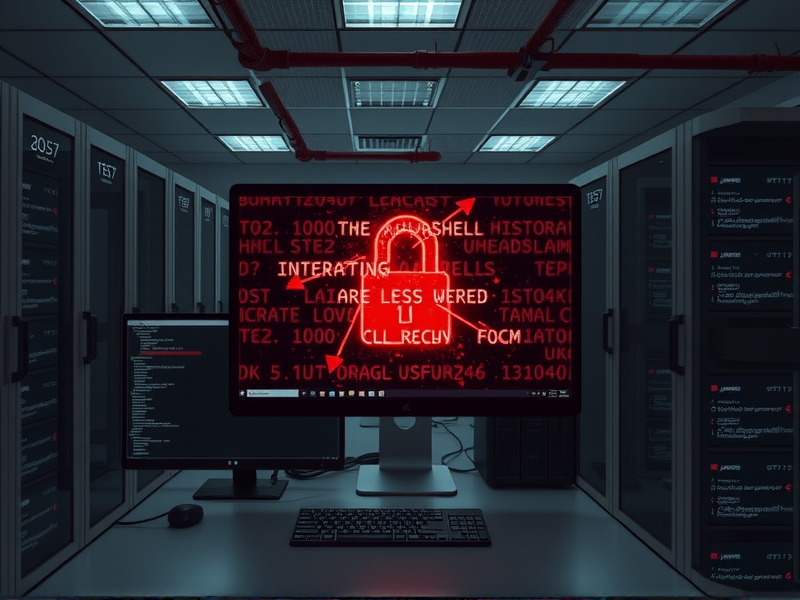Threat Overview
In a recent publication dated 2025‑10‑30, AlienVault released a comprehensive threat report titled “A Deep Dive Into Warlock Ransomware Deployed Via ToolShell SharePoint Chained Vulnerabilities.” The analysis identifies Warlock as a highly sophisticated ransomware family that leverages newly disclosed SharePoint vulnerabilities (CVE‑2025‑53770 and CVE‑2025‑53771) to gain initial foothold within an organization. The report highlights a multi‑stage attack chain that begins with the exploitation of these CVEs through a custom ToolShell module, followed by lateral movement, privilege escalation, and ultimately the deployment of the ransomware payload. The confidence level assigned to the findings is 100, indicating complete reliability.
Attack Vector and Initial Compromise
Warlock’s first step is to exploit the chained SharePoint vulnerabilities, which allow unauthenticated remote code execution on affected servers. The attacker delivers a malicious payload via the ToolShell framework, a lightweight shell that can execute arbitrary commands on compromised hosts. Once the payload is executed, the attacker gains a foothold and begins reconnaissance, mapping the internal network and identifying high‑value targets such as file servers, backup storage, and domain controllers. The use of chained vulnerabilities means that a single successful exploitation can lead to rapid expansion across the environment.
Malware Behavior and Encryption Engine
After establishing persistence, Warlock initiates a multi‑stage execution sequence. It first terminates critical security services, including antivirus and endpoint detection and response agents, to reduce the likelihood of detection. The malware then removes recovery options such as System Restore points and deletes Volume Shadow Copies, ensuring that victims cannot revert to a pre‑infection state. The encryption engine is a hybrid scheme that combines ChaCha20 for bulk file encryption and Curve25519 for key exchange, providing both speed and strong cryptographic security. The ransomware also includes a hostname verification routine that checks the target system’s name against a whitelist; systems on the list are bypassed, indicating a calculated self‑preservation strategy to avoid encrypting the attacker’s own infrastructure.
File Targeting and Persistence
Warlock mounts all unmounted volumes and scans for files with extensions commonly used for documents, spreadsheets, databases, and code. It explicitly skips directories such as system32, Windows, and Program Files to avoid corrupting critical OS files. Encrypted files receive a new extension, .x2anylock, and the original filename is appended to the encrypted payload. The ransomware also stops specific services and processes identified during reconnaissance, ensuring that the encryption process runs uninterrupted. In addition, the malware modifies registry keys to maintain persistence across reboots, leveraging the HKLM\Software\Microsoft\Windows\CurrentVersion\Run key.
Indicators of Compromise
Security analysts should look for the following indicators: the presence of a ToolShell executable with a unique hash, the creation of a .x2anylock file extension, sudden termination of security services, deletion of shadow copies, and registry modifications under HKLM\Software\Microsoft\Windows\CurrentVersion\Run. Network traffic to known malicious IP addresses associated with the CVE exploitation chain, as well as anomalous outbound connections to command‑and‑control servers, are also strong indicators. The report lists 35 connected elements, including file paths, registry keys, and network endpoints that can be used to build detection rules.
Detection and Monitoring Recommendations
Implement real‑time monitoring for the following behaviors: execution of ToolShell scripts, changes to critical system services, deletion of shadow copies, and creation of .x2anylock files. Deploy endpoint detection and response solutions that can detect the specific ChaCha20 and Curve25519 cryptographic patterns. Use file integrity monitoring to flag unauthorized modifications to system binaries and registry keys. Additionally, maintain an up‑to‑date inventory of SharePoint servers and ensure that CVE‑2025‑53770 and CVE‑2025‑53771 are patched promptly. Threat intelligence feeds should be cross‑referenced with the external references provided in the report to stay ahead of new variants.
Mitigation Strategies
Patch Management: Apply the latest Microsoft security updates that address CVE‑2025‑53770 and CVE‑2025‑53771 immediately. Access Control: Restrict SharePoint administrative privileges and enforce the principle of least privilege for all users. Backup Strategy: Maintain offline, immutable backups of critical data and test restore procedures regularly. Incident Response: Prepare a playbook that includes isolation of affected hosts, preservation of forensic evidence, and communication with stakeholders. Security Awareness: Train users to recognize phishing attempts that may deliver the initial ToolShell payload.
Recommendations for Security Analysts
Security teams should incorporate the findings of this report into their threat hunting activities. Use the detailed TTPs and IOCs to build custom detection rules in SIEM and EDR platforms. Share the report’s insights with the broader security community through threat intelligence platforms such as AlienVault OTX. Finally, conduct tabletop exercises that simulate a Warlock infection to validate response readiness and refine mitigation controls.
For further details, see the full report at Hybrid Analysis Blog and the AlienVault pulse at OTX Pulse.


